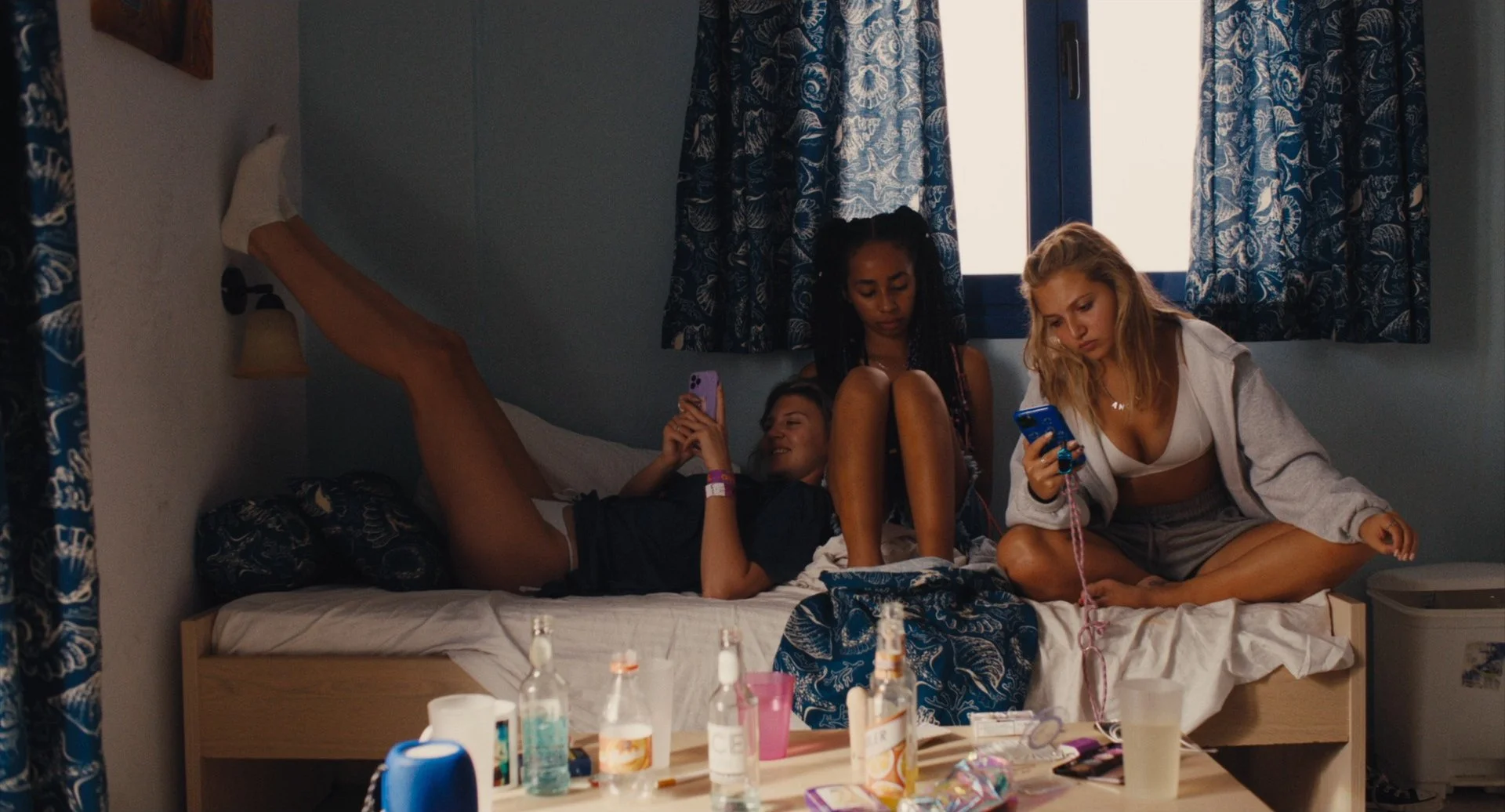Example: How to Have Sex and Michael Chekhov’s Psychological Gesture
The film How to Have Sex, directed by Molly Manning Walker, shows the three young women at the center of the film in ‘messy’ and ‘uninhibited’ state: drunk, hungover, upset, overwhelmed, playful, and even drunkenly eating fries while sitting in the street at 2 in the morning after a night out. We see one girl throwing up the morning after. This is one of the most ‘raw’ depictions of young women on film that I have seen in a while.
In our SIP film Favouritism, there is a scene of the five female protagonists curled up together in bed, hungover after a night of partying. My character, Gemma, sits up and drinks from a water bottle, and then passes it to the other girls. I used the image below of a character from How to Have Sex as my reference for this shot. While the image appears to be natural, raw, and messy, when I replicated the actress’s posture for our scene in Favouritism, I noticed that I felt profoundly unnatural.
I was seated in a way that allowed my body to ‘cheat’ to camera. My gaze, which was meant to be looking off into the distance in an effort to to fixate on some sort of horizon line to avoid nausea, was in actuality an entirely technical sequence: a pre-determined eyeline that fell somewhere between the side of the camera and the DOP’s elbow. In real life, if I was as hungover as the characters in our film claimed to be, I would have likely been entirely horizontal, or laying down with my head propped up on pillows, eyes closed, reaching between water or Gatorade.
My hyper-awareness of the camera dictated every aspect of how I positioned my body in relation to the camera. Between the mic-pack, my tiny shorts, bikini strings that constantly had to be adjusted, re-adjusting of my necklace for continuity, and an effort to move my body in a way that wouldn’t make my legs look ‘fat’ on camera, and lean back in such a way that I wouldn’t go ‘too far down’ to be out of frame, but not too far up to block the close-up shots of the other actresses, I’d argue that my ‘naturalistic’ interpretation of appearing hungover on screen was almost entirely unnatural. Where it was ‘real’ was the use of memory I employed to draw upon past lived experiences. I would also argue that my reasons for my ‘unnatural’ positioning are not entirely due to my own self consciousness, as I will explain more in depth below.
The unique craft of Screen Acting requires the actor to prioritize continuity over impulse. In an ideal setting, the two would work in tandem, but due to time constraints and awareness of what is needed for the editor, filmmaking requires the actor to replicate the same sequence of gestures in each take of a scene. In order for the final edited scene to appear as one smooth sequence. The scene is filmed in multiple takes, from multiple angles and multiple levels of distance from the actor’s face. (This is why actors sometimes ask ‘what’s my framing?’ before a take.)
With this in mind, I utilized a an acting technique called Psychological Gesture, which was coined by acting practitioner Michael Chekhov. Psychological Gesture takes an impulse in the body and assigns it a beginning, middle, and end. In the case of Favouritism, my gesture sequence was the following: 1) I looked to the left of camera while sitting forward on the edge of the bed. From my abdomen, I made tiny, barely detectable circles with my upper body, to give the impression that my character’s head was spinning. 2) I leaned forward, and with my left arm, reached for a crumpled water bottle positioned on the floor in front of the bed, and ‘stumbled around’ for it 2-3 times before finding the water bottle. 3) I picked up the water bottle in my left hand and held it at an angle across my mouth, to replicate the position of the bottle in the image below in How to Have Sex (because honestly, I liked the look of it — I thought it created a strong visual image.) 4) I took a tiny sip of water, winced a bit, and without looking back, passed the water bottle back to another character laying further back on the bed. Next, at my cue, I reached with my right hand for a cellphone and leaned back to show a photo to another character. I repeated this sequence over and over again for about two hours.
Michael Chekhov’s psychological gestures gave me a technical anchor in the scene where I could track what I was doing in each moment to help tell the story and helped me ensure that I was giving the same performance time and time again to help the editor in post production. I created variety in my performance through minor changes in my character’s objective and facial expressions to give the director and editor different options.
Another interesting thing to note is that although I was playing a character in her twenties who parties a lot, I’m in my early 30s and my late nights and hungover mornings are becoming farther and farther between. Because of this, it felt less second nature to recall the precise physicality of a young woman hungover in bed surrounded by her best friends, and I felt less ‘authentically messy.’
Therefore, I would argue that the following factors contributed to my experience of struggling to portray ‘authentic messiness’ on screen: contorting my body to adhere to the blocking needed to favor the camera, my own self-consciousness of my body’s appearance on film, and continuity. Although Michael Chekhov’s Psychological Gestures helped me as a screen actor, this technique did not make me feel more connected to my natural impulse. I utilized my own impulses at the root of psychological gesture and memory recall of the experience of being in bed hungover to create authenticity within the scene, but the ‘mess’ of what we see through the camera is entirely contrived.








